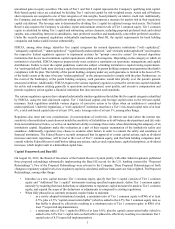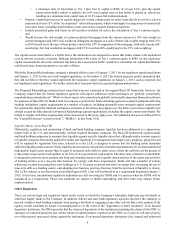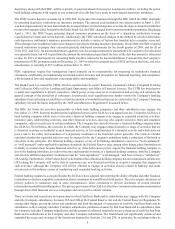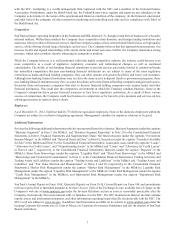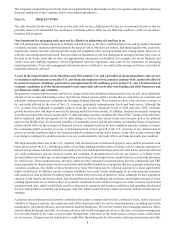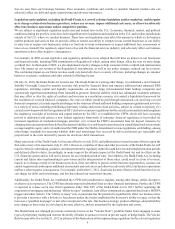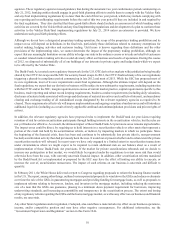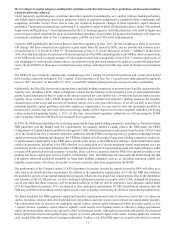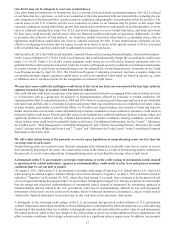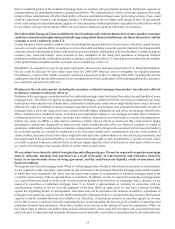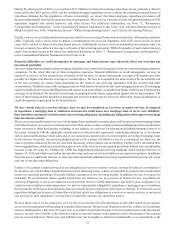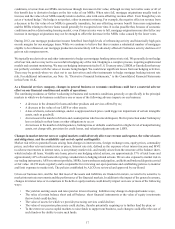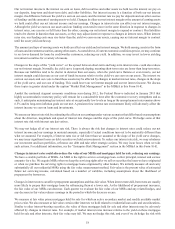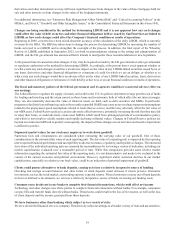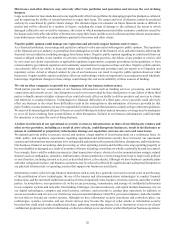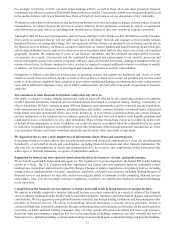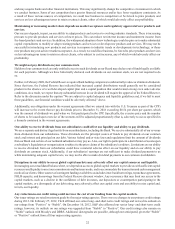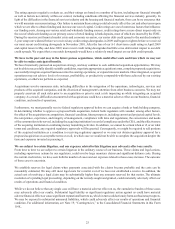SunTrust 2012 Annual Report Download - page 29
Download and view the complete annual report
Please find page 29 of the 2012 SunTrust annual report below. You can navigate through the pages in the report by either clicking on the pages listed below, or by using the keyword search tool below to find specific information within the annual report.13
Our ALLL may not be adequate to cover our eventual losses.
Like other financial institutions, we maintain an ALLL to provide for loan defaults and nonperformance. Our ALLL is based
on our historical loss experience, as well as an evaluation of the risks associated with our loan portfolio, including the size
and composition of the loan portfolio, current economic conditions and geographic concentrations within the portfolio. The
current stress on the U.S. economy and the local economies in which we do business may be greater or last longer than
expected, resulting in, among other things, greater than expected deterioration in credit quality of our loan portfolio, or in the
value of collateral securing these loans. Our ALLL may not be adequate to cover eventual loan losses, and future provisions
for loan losses could materially and adversely affect our financial condition and results of operations. Additionally, in order
to maximize the collection of loan balances, we sometimes modify loan terms when there is a reasonable chance that an
appropriate modification would allow our client to continue servicing the debt. If such modifications ultimately are less
effective at mitigating loan losses than we expect, we may incur losses in excess of the specific amount of ALLL associated
with a modified loan, and this would result in additional provision for loan losses.
On December 20, 2012, the FASB issued for public comment a Proposed Accounting Standards Update, Financial Instruments–
Credit Losses (Subtopic 825-15) (the Credit Loss Proposal), that would substantially change the accounting for credit losses
under U.S. GAAP. Under U.S. GAAP's current standards, credit losses are not reflected in financial statements until it is
probable that the credit loss has been incurred. Under the Credit Loss Proposal, an entity would reflect in its financial statements
its current estimate of credit losses on financial assets over the expected life of each financial asset. Comments on the Credit
Loss Proposal are due by April 30, 2013. The Credit Loss Proposal, if adopted as proposed, may have a negative impact on
our reported earnings, capital, regulatory capital ratios, as well as on regulatory limits which are based on capital (e.g., loans
to affiliates) since it would accelerate the the recognition of estimated credit losses.
We may have more credit risk and higher credit losses to the extent our loans are concentrated by loan type, industry
segment, borrower type, or location of the borrower or collateral.
Our credit risk and credit losses can increase if our loans are concentrated in borrowers engaged in the same or similar activities
or in borrowers who as a group may be uniquely or disproportionately affected by economic or market conditions. We
experienced the effect of concentration risk in 2009 and 2010 when we incurred greater than expected losses in our residential
real estate loan portfolio due to a housing slowdown and greater than expected deterioration in residential real estate values
in many markets, particularly several Florida MSAs. As Florida is our largest banking state in terms of loans and deposits,
further deterioration in real estate values and underlying economic conditions in those markets or elsewhere could result in
materially higher credit losses. Florida and other states in our footprint have suffered significant declines in home values and
significant declines in economic activity. A further deterioration in economic conditions, housing conditions, or real estate
values in these states could result in materially higher credit losses. For additional information, see the "Loans", "Allowance
for Credit Losses", “Risk Management–Credit Risk Management” and “Critical Accounting Policies–Allowance for Credit
Losses” sections in the MD&A and Notes 6 and 7, "Loans" and "Allowance for Credit Losses", to the Consolidated Financial
Statements in this Form 10-K.
We will realize future losses if the proceeds we receive upon liquidation of nonperforming assets are less than the
carrying value of such assets.
Nonperforming assets are recorded on our financial statements at the estimated net realizable value that we expect to receive
from ultimately disposing of the assets. We could realize losses in the future as a result of deteriorating market conditions if
the proceeds we receive upon dispositions of nonperforming assets are less than the carrying value of such assets.
A downgrade in the U.S. government's sovereign credit rating, or in the credit ratings of instruments issued, insured
or guaranteed by related institutions, agencies or instrumentalities, could result in risks to us and general economic
conditions that we are not able to predict.
On August 5, 2011, S&P cut the U.S. government's sovereign credit rating of long-term U.S. federal debt to AA+ from AAA
while keeping its outlook negative. Further, Moody's lowered its outlook to "Negative" on June 2, 2011 and Fitch lowered its
outlook to "Negative" on November 28, 2011, where they both remain. As a result, there continues to be the perceived risk
of a sovereign credit ratings downgrade of the U.S. government, including the rating of U.S. Treasury securities. It is foreseeable
that the ratings and perceived creditworthiness of instruments issued, insured or guaranteed by institutions, agencies or
instrumentalities directly linked to the U.S. government could also be correspondingly affected by any such downgrade.
Instruments of this nature are key assets on the balance sheets of financial institutions, including us, and are widely used as
collateral by financial institutions to meet their day-to-day cash flows in the short-term debt market.
A downgrade of the sovereign credit ratings of the U.S. government and perceived creditworthiness of U.S. government
-related obligations could impact our ability to obtain funding that is collateralized by affected instruments, as well as affecting
the pricing of that funding when it is available. A downgrade may also adversely affect the market value of such instruments.
We cannot predict if, when or how any changes to the credit ratings or perceived creditworthiness of these organizations will
affect economic conditions. Such ratings actions could result in a significant adverse impact on us. In addition, we presently


